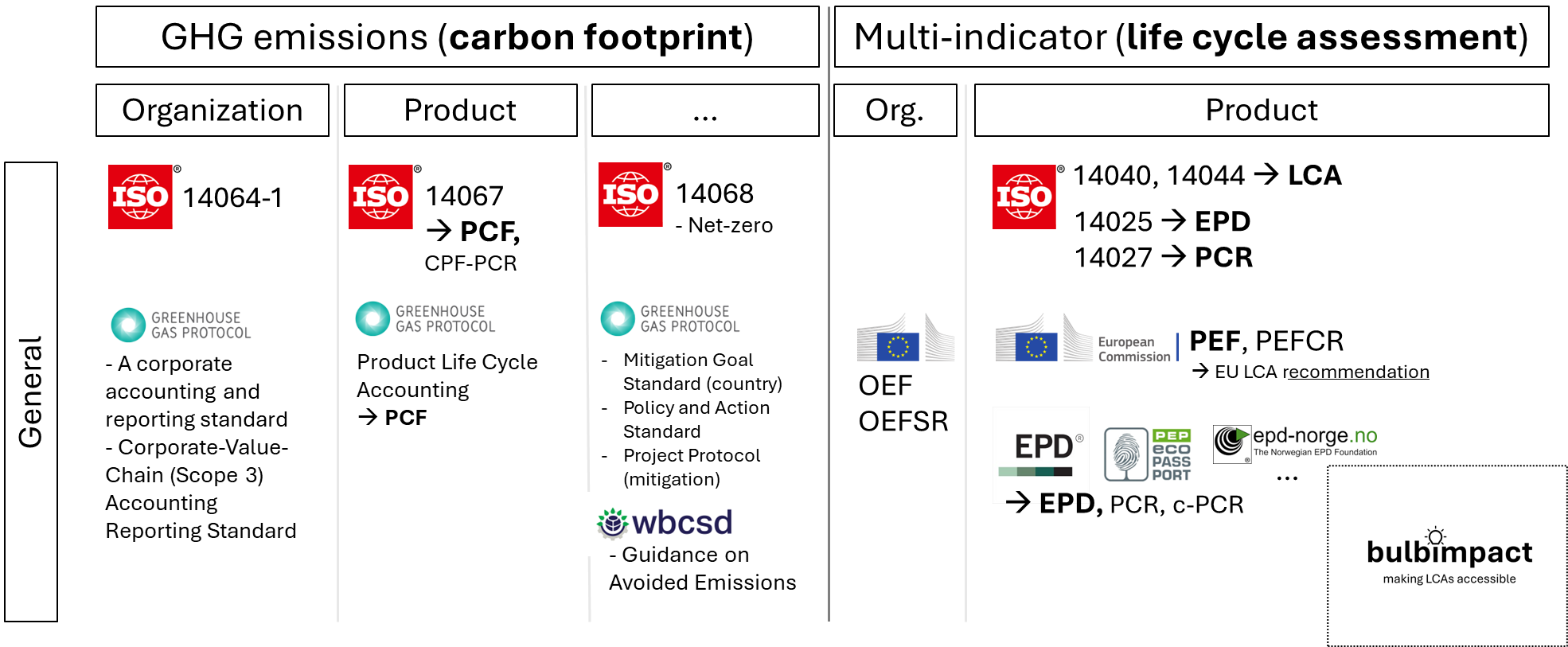Introduction to the Series
Life cycle assessment (LCA) and Product Carbon Footprint (PCF) methodologies have become fundamental tools in assessing environmental impacts of products across industries. Among the most prominent general LCA frameworks are the Product Environmental Footprint (PEF) and Environmental Product Declaration (EPD) while for PCF there are the ISO 14067 and GHG product standard. This article is the first in a series aimed at providing a rigorous comparison of these methodologies, helping sustainability professionals navigate their complexities and applications.
Read time: 5 minutes
Introduction to the Topic
This article sets the stage by exploring the origins, development timelines, interconnections with other standards, and current market adoption of PEF, EPD, ISO 14067 and GHG product standards. Understanding these aspects is crucial for stakeholders aiming to align their sustainability strategies with internationally recognized frameworks.
The Origin of PEF, EPD, and PCF
Developed as part of the EU’s Sustainable Consumption and Production Action Plan, the Product Environmental Footprint (PEF) initiative [1,2] was launched by the European Commission in 2013. It aims to harmonize, third-party verified, LCA study for measuring, comparing and communicating the environmental performance of products. The PEF methodology underwent a pilot phase (2013-2018) focused on developing PEF Category Rules (PEFCR) to ensure methodological consistency across product types. With an official Commission Recommendation published in 2021 [3], the methodology is now in a transition phase [2]. A review of the Recommendation is expected for 2026 [10]. More importantly, studies show that PEF has been increasingly mentioned in European policies over the last decades [4,5].
Environmental Product Declarations (EPD) are third-party verified declarations providing comprehensive environmental impact data. They are rooted in the ISO 14025 standard and are developed under various international and regional programs, such as the International EPD System [6] and national EPD programs [7]. Since the advent of EPDs in the 1990s, various sectors and regions have developed industry-specific Product Category Rules (PCRs).
The ISO 14067 was first published by the International Organization for Standardization (ISO) in 2013 [8]. It focuses specifically on the product carbon footprint (PCF) and provides guidelines for quantifying and reporting GHG emissions associated with the life cycle of products. The current active standard is the ISO 14067:2018 and will be replaced by the ISO/AWI 14067 which is under development [8].
Like ISO 14067, the GHG Product Standard [9] is a PCF standard that focuses on GHG emissions over the life cycle of a product. It was developed between 2007 and 2010. The GHG Protocol is best known for its corporate accounting and reporting standard published in 2001.
The Link Between PEF, EPD, PCF and Other Standards
PEF, EPD, ISO 14067, and GHG Product Standard do not operate in isolation; they align with and complement several other standards and frameworks:
- ISO 14040/14044: These fundamental LCA standards provide the methodological basis for the PEF, EPD and ISO 14067.
- ISO 14025: This ISO is about environmental labels and declarations of Type III such as EPD. It governs the principles and requirements to develop EPD programs.
- EN 15804: It is a product category rule (PCR) providing core rules for EPDs in the construction sector, ensuring alignment with sustainability assessments in the built environment.
Current Market Adoption
Market adoption of these methodologies varies by region and industry:
- PEF: Mainly adopted in the EU, with increasing interest due to its mention in EU policies (European Green Deal, Green Claim Directive proposal, Circular Economy Action Plan, EU taxonomy, …).
- EPD: Widely used across industries such as construction, automotive, and packaging, with growing demand driven by green procurement policies.
- ISO 14067 & GHG Product Standard: Take advantage of the focus on carbon footprints and the widespread adoption of related corporate reporting standards.
Conclusion
The PEF, EPD, ISO 14067 and GHG Product Standard methodologies each bring unique strengths to environmental impact assessment. While the PEF offers a comprehensive, EU-driven approach, EPDs provide globally recognized, sector-specific guidelines, and the PCF standards benefits from the widespread adoption of corporate GHG reporting standards. Understanding their origins, development timelines and interrelationships is key for sustainability professionals seeking to help their clients improve their environmental performance and meet regulatory and market expectations.
Do you have any question ?
Feel free to reach out.
Sources:
- https://green-business.ec.europa.eu/environmental-footprint-methods_en
- https://eplca.jrc.ec.europa.eu/EnvironmentalFootprint.html
- European Commission, Directorate-General for Environment. (2021). Commission Recommendation (EU) 2021/2279 of 15 December 2021 on the Use of the Environmental Footprint Methods to Measure and Communicate the Life Cycle Environmental Performance of Products and Organisations. http://data.europa.eu/eli/reco/2021/2279/oj
- Sala, S., Amadei, A. M., Beylot, A., & Ardente, F. (2021). The evolution of life cycle assessment in European policies over three decades. The International Journal of Life Cycle Assessment, 26, 2295-2314.
ISO 690 https://doi.org/10.1007/s11367-021-01893-2 - Jegen, M. (2024). Life cycle assessment: from industry to policy to politics. The International Journal of Life Cycle Assessment, 29(4), 597-606. https://doi.org/10.1007/s11367-023-02273-8
- https://www.environdec.com/home
- https://www.eco-platform.org/the-eco-epd-programs.html
- https://www.iso.org/standard/71206.html
- https://ghgprotocol.org/product-standard
- Environmental Footprint methods newsletter (03.02.2025)

Leave a Reply